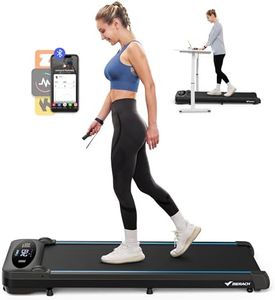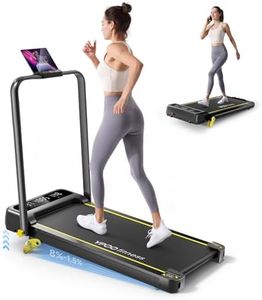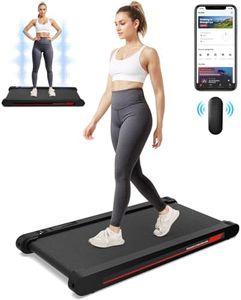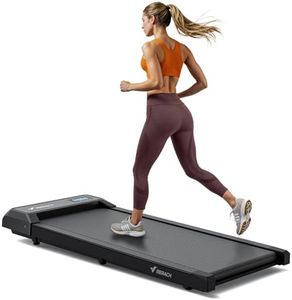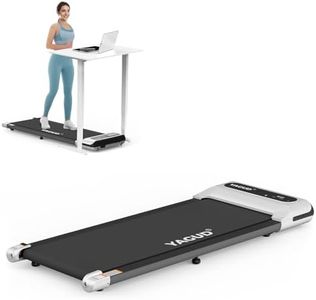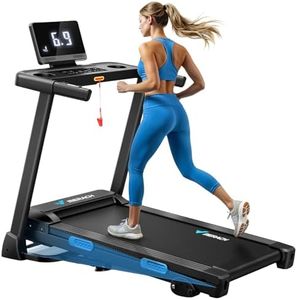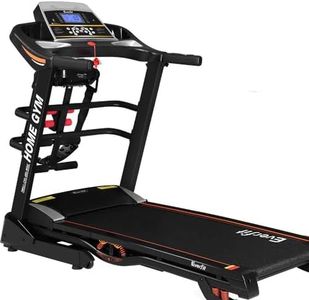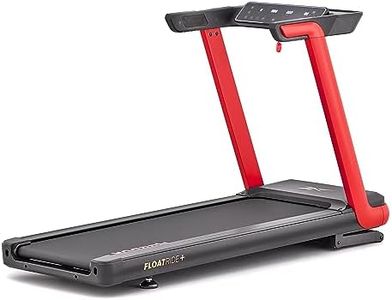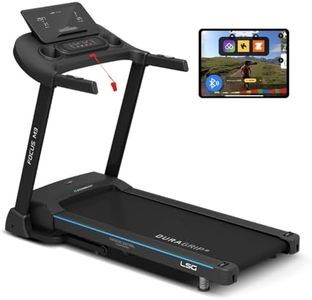We Use CookiesWe use cookies to enhance the security, performance,
functionality and for analytical and promotional activities. By continuing to browse this site you
are agreeing to our privacy policy
10 Best Treadmills For Home Use
From leading brands and best sellers available on the web.Buying Guide for the Best Treadmills For Home Use
Buying a treadmill for home use can be a great step towards maintaining your fitness without having to leave your house. With so many options available, it's important to think about how much space you have, how often you plan to use the treadmill, and what kind of workout experience you want. The key is to match the treadmill’s features with your personal fitness goals and the environment in which you’ll use it. By understanding the most important specifications, you can choose a treadmill that is both practical and enjoyable to use.Motor Power (Horsepower/HP)The motor power of a treadmill is usually measured in horsepower (HP) and determines how smoothly and reliably the treadmill runs, especially at higher speeds or with heavier use. For gentle walking, a lower motor power can suffice, while running or frequent use demands a stronger motor to prevent overheating and wear. Motors are typically divided into continuous duty power (the power it can maintain over time) and peak power (the maximum it can reach). For light walking, motors around 1.5 to 2.0 CHP (continuous horsepower) are fine; for jogging and running, look for 2.5 CHP or higher. If you plan to run often or if multiple household members will use the treadmill, choosing a stronger motor ensures durability and a smoother experience.
Running Surface Area (Belt Size)The running surface refers to the length and width of the treadmill belt and is an important comfort and safety consideration. A longer and wider belt provides more room to move freely, which is essential if you have a long stride or plan on running. Walking treadmills often have belts that are about 16-18 inches wide and 45-50 inches long, while running treadmills have belts that are 20 inches or more wide and over 55 inches long. If you’re tall or plan to run, aim for the larger size. If space is tight and you only want to walk, a shorter, narrower belt may be sufficient and can save space.
Cushioning SystemTreadmill cushioning is the shock-absorbing feature beneath the belt that reduces impact on your joints compared to running on pavement. This makes workouts more comfortable and helps prevent injuries, especially during longer or more frequent sessions. Cushioning can range from basic to advanced systems. If you have joint concerns or run often, look for models with more advanced or adjustable cushioning. If you mostly walk, basic cushioning should suffice, but any level of impact reduction is beneficial for long-term joint health.
Incline OptionsIncline features allow you to raise the treadmill running surface, simulating uphill walking or running. This increases workout intensity and helps target different muscle groups. Incline can be manual (you set the slope yourself before workout) or automatic (you can change it during activity with just a button). Manual inclines are simpler, but automatic options are more convenient and motivating if you like to mix up workouts or follow built-in training programs. Choose a treadmill with at least a 10% incline for challenging sessions, but if you only plan light activities, less incline is enough.
Speed RangeThe maximum and minimum speed settings determine what types of exercise the treadmill can handle. Most treadmills start at a slow pace appropriate for walking (around 0.5 mph) and go up to a top speed for running (between 8-12 mph). If you’re only interested in walking, a lower top speed is sufficient. Runners or those looking to do sprint intervals will want higher speed capabilities to match their workout needs. Make sure the treadmill matches the fastest pace you expect to reach.
Foldability and StorageMany home treadmills offer foldable designs, allowing the running deck to be lifted and locked in place for easier storage when not in use. This is important if you have limited space or want to keep your living area clear. Some fold easily with assistance from hydraulic systems, while others are manual and may require more strength to move. If you have a dedicated space, foldability might not matter as much, but for apartments or multipurpose rooms, this feature can be a major convenience.
Weight CapacityEach treadmill is built to handle a certain maximum user weight. This spec ensures safety, optimal function, and durability. Weight capacities generally range from 200 to over 300 pounds. If you or other users are near the upper limit of a treadmill’s capacity, it's best to choose a machine with a higher rating for added peace of mind and longevity.
Console Features (Display, Connectivity, Programs)The treadmill console can show your pace, distance, calories burned, and more. Many modern treadmills also feature built-in workout programs, Bluetooth speakers, or tablet holders to make exercise more engaging. Some link to fitness apps or provide heart rate monitoring. Think about which features will keep you motivated—if simple tracking is enough, a basic display will do, but if you like interactive experiences, opt for models with connectivity and workout variety.
